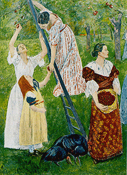

![]()
![]()
This Page:
Introduction
Modern Woman Mural
Other Cassatt Exhibits
![]()
![]()
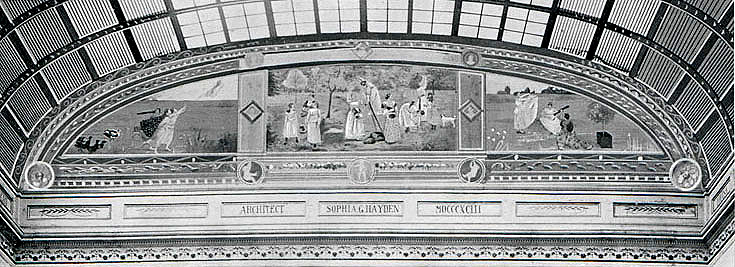
Left: Girls Pursuing Fame Center: Young Women Plucking the Fruits of Knowledge or Science Right: Arts, Music, Dancing
View the large size of this mural with border here
--scroll down the page
to the Interior of the Woman's Building (and click to enlarge the photo)
to see the HUGH SIZE
of the mural (58 x 12 feet), although the details
of the mural are obscured by the reflected light on it. The three panels
were surrounded by
a 3-foot-wide, Renaissance-inspired border.

Self-portrait 1880.
Born into a wealthy Pittsburgh family, Mary Cassatt (1844-1926) was one of the new breed of nineteenth-century expatriate women who went to Paris to study art and stayed there permanently. Now recognized as one of America's great impressionists, Cassatt was not well-known in America until she was asked to contribute to the 1893 World's Columbian Exhibition and Fair in Chicago by painting a 58 x 12 foot mural for the north tympanum over the entrance to the Gallery of Honor in the Woman's Building.
Unfortunately, after the Woman's Building was later pulled down, Cassatt's mural was lost. However, some photographs were taken and colored prints made of her mural. In addition, while she was creating it in 1892 and for the next year or two, she also made a series of prints and paintings playing variations on the mural motifs.
The goal of the Woman's Building was to showcase the advancement of women throughout history. The assigned theme for Cassatt's mural was "Modern Woman." At the opposite end of the Gallery of Honor was a complementary mural on "Primitive Woman" created by Mary Fairchild MacMonnies.
Cassatt designed her mural as an allegorical triptych. The central panel titled Young Women Plucking the Fruits of Knowledge or Science (see above) featured contemporary women picking fruit from a contemporary "tree of knowledge" and passing it on to the younger generation. The left panel was an image of Young Girls Pursuing Fame and the right panel displayed young women engaged in activities associated with the Arts, Music, Dancing.
Included below are scans I made of photographs of Cassatt's mural as it was displayed in the Woman's Building. There are also images of the other pictures Cassatt exhibited at the 1893 Exposition.
![]()
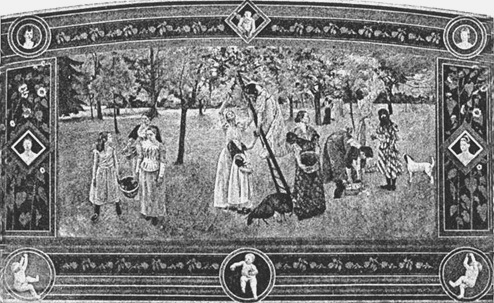
Young Women Plucking the Fruits of Knowledge or Science (central panel)
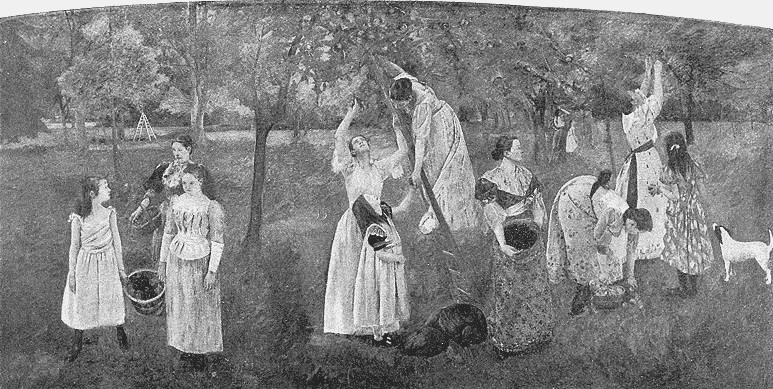
Mary Cassatt's Young Women Plucking the Fruits of Knowledge or Science.
Central panel of the mural for the tympanum over the entrance to the Gallery of Honor
in the Women's Building at the Columbian Exposition and World Fair, Chicago, 1893.
This image was scanned from a photo in Harper's New Monthly Magazine 86.516 (May 1893):837.

Young Girls Pursing Fame (left panel)

Arts, Music, Dancing (right panel)
In the left panel, three girls (one in a dark blue dress) reach for "Fame" shown in the upper right corner as a flying female figure whose nudity represents discarding the conventional constraints of society that inhibit accomplishment (especially for girls?). In the left corner is a gaggle of geese, the import of which nobody seems to know, but let me hazard a guess that they represent conventional society "quacking" its disapproval of such unconventional aspirations.
The right panel also features three women--perhaps the three girls grown to adulthood and the accomplishments they sought in the left panel? In the center, a woman plays the banjo (see variations on this motif below). To her left, a woman in a popular-styled "accordian" skirt dances. The woman on the right observes appreciatively.
The mural's "brilliancy of color" was often noted--bright yellow-greens, intense blues, deep plum or purple, peach--but not always approvingly by those put off by the "unnatural" colors of the impressionistic palette. (Source: here--scroll down the page). Judged by the colored print below, it is hard to imagine why some critics were so upset by her "vivid hues," but one protested that her "impudent greens" and "brutal blues" "assault" the eye. Another critic referred to the "greenery-yallery" effect, supposedly conjuring up visions of Beardsley and the Decadents. However, as Cassatt herself noted, "I have tried to make the general effect as bright, as gay, as amusing as possible. The occasion is one of rejoicing, a great national fete. . . ." (Letter to Mrs. Bertha Palmer, President of the Board of Lady Managers, Women's Building.)

1893 print of Cassatt's Modern Woman Mural
(printed by George Barrie).
More neutrally, other critics noted the flat Japanese effect of the middle panel, its red and gold fruit, the vivid green grass, and purple skirts, pink frocks, and (on the right panel) the heliotrope accordian skirt of the dancer.
The wide border around the middle section of the mural--and presumably around all three panels of the triptych--is described as a "rich border" of blue, green, and orange with a dominance of greens, blues, purples. Some critics pronounced it as "too strong a framing device."
According to art historian Nancy Matthews,
"With the help of published reproductions and Cassatt's own words, the mural's meaning becomes clear, particularly when considered in the context of late-nineteenth-century women's issues. For instance, the theme of the central panel, Young women Plucking the Fruits of Knowledge or Science, probably alludes to women's recently acquired access to college education. Even more radical, Cassatt's depiction of women passing the fruits of knowledge from one generation to the next can be seen as a direct assault on traditional religious interpretations of the Story of Adam and Eve in the Book of Genesis.
The two side panels, Young Girls Pursuing Fame and Arts, Music and Dancing expand Cassatt's central thesis. In the left-hand panel three young girls, placed in a landscape setting, chase a flying figure who, according to Cassatt, personifies fame. In its own time, this panel, with its provocative title, was intended to be a frank attack on the notion of young middle-class women as demure and self-effacing, a challenge to the powerful and seductive "cult of true womanhood." In Cassatt's view, girls who sought renown could, through education, fulfill their dreams.
Such achievements are the subject of the right-hand panel, where three self-confident and assured women in modern dress represent the artist, musician, and dancer. Rather than being the creative muses of men, they are accomplished persons in their own right.
Seen together the three panels represent a woman's life cycle--childhood, youth, and maturity--as well as self-fulfillment, a reflection of Cassatt's own experience."
Cassatt ordered new Paris gowns for her models to suggest their "modernity," but the actual models tended to be country women whose robust health Cassatt found more attractive than conventional notions of feminine beauty. Perhaps more "modern" was her contemporary update of the 18th Century "modern" beauties of Japanese printmakers like Utamaro, as well as her avant-garde impressionistic techniques of handling light and color (no muddy browns, for instance).
Cassatt herself felt that her community of independent women was a very modern theme. As she put it in a letter to Bertha Palmer, the President of the Board of Lady Managers for the Women's Building at the 1893 World Fair,
"An American friend asked me in rather a huffy tone the other day 'Then this is woman apart from her relations to man?' I told him it was."

Portrait of a Lady--It is unclear if this image is
the
Portrait of a Ladywhich was exhibited in
the Women's Building, 1893 Exposition

The Parrot
1889-1890
(drypoint)--exhibited
in Women's Building,
1893 Exposition.

French Peasant
Woman
with a Child (dry point)--
exhibited in Women's
Building, 1893 Exposition.
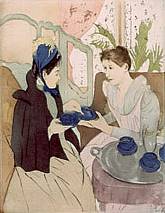
Afternoon Tea Party 1890-91 (drypoint and aquatint)--
exhibited in Woman's Building,
1893 Exposition.
Another Cassatt painting/print at the 1893 Exposition was The Bath, but no more information is available. Therefore, I have included three different "bath" paintings, which also illustrate three different styles in which Cassatt worked. If one of these is the correct Bath, it was exhibited in the Woman's Building.

The Bath
--about 1890-91
Soft-ground etching with aquatint
and drypoint on paper
Influence of Japanese prints.
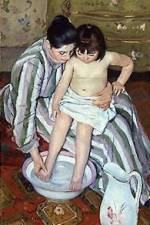
The Bath
1891-92, oil painting.
Japanese print techniques adapted
to contemporary European subjects.

The Bath 1892.
![]()
![]()
Carr, Carolyn Kinder and Sally Webster. "Mary Cassatt and Mary Fairchild MacMonnies: The Search for Their 1893 Murals. " American Art 8.1 (Winter 1994): 52-69.
Chalmers, F. Graeme. Women in the Nineteenth Century Art World. Westport 1988.
Galvin, Paul V. World's Columbian Exposition of 1893. Library Digital History Collection, Illinois Institute of Technology.
Mathews, Nancy Mowll. Mary Cassatt: A Life. New York: Harry N. Abrams in association with the National Museum of American Art, Smithsonian Institution, 1987.
Remediating Rhetorical Room at the 1893 chicago World's Fair: Lucy Stone, Mary Cassatt, and Ida B. Wells--dissertation by Yvonne R. Schultz focusing on three significant independent women's work: suffragist Lucy Stone’s speech “The Progress of Fifty Years”; impressionist Mary Cassatt’s mural "Modern Woman"; and Black journalist Ida B. Wells’s "The Reason Why the Colored American Is Not in the World’s Columbian Exposition: The Afro-American’s Contribution to Columbian Literature."
Weimann, Jeanne Madeline. The Fair Women. Chicago 1981.
![]()
![]()
Go to Cassatt's Modern Women, p. 2
Return to Women's Public Art & Architecture
Return to Site Index
![]()
![]()
Text written by K. L. Nichols
Painting, top of page: Selection from the central panel of
Mary Cassatt's Modern Women Mural
(1893)
Return to Nichols Home Page
Suggestions/Comments: knichols11@cox.net
Posted: 6-25-02; Updated: 5-2-20